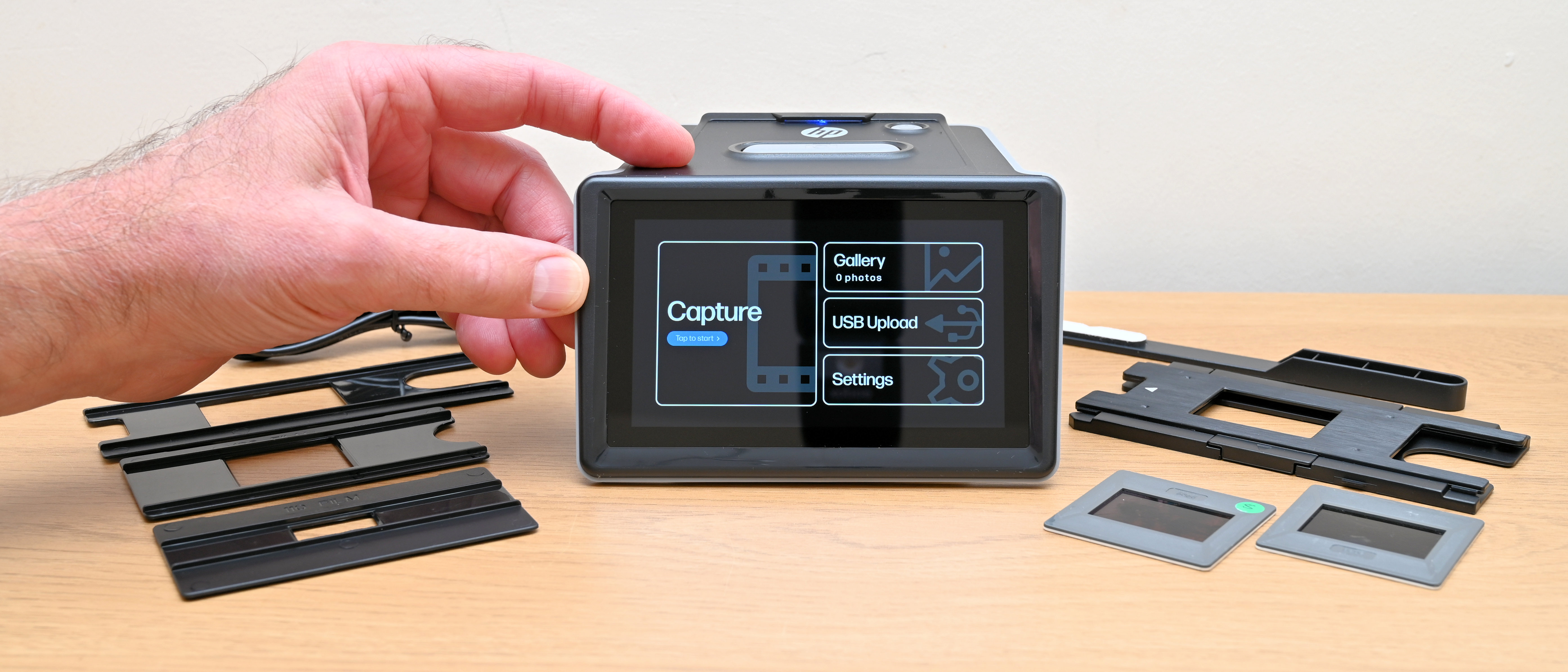HP FilmScan 5” Touch Screen Film Scanner review: get your old negs and slides out of the shoebox and into the digital realm

Skip to main content
Close main menu
Digital Camera World
THE HOME OF DIGITAL PHOTOGRAPHY
View Profile
Search Digital Camera World
Accessories
Buying Guides
The Photography & Video Show
Digital Camera
Australian Camera
Australian ProPhoto
Photography Magazines
Why subscribe?
Issues filled with product reviews, latest updates, expert advice and more
Delivered to your Android or IOS device
Every issue is packed with photo tips, kit reviews and inspiration
From$12Subscribe now
Camera news
Camera rumors
Photography & Video Show
Cheatsheets
Photo mag deals
Prime Day deals
Don’t miss these
HP launches new film scanner, making saving memories simple
The best slide viewers in 2025: the easy way to rediscover your old slides
Epson ELPDC21 Document Camera review
Kodak slashes the cost of its film scanners in Amazon Prime Day sale
Digital Cameras
AgfaPhoto Realishot C130 review: a smart compact camera that takes the long view
Compact Cameras
Kodak Pixpro C1 review: retro compact or just a cheap point and shoot?
Video Cameras
Camp Snap CS-8 review: This retro camera takes low-quality, dated videos – but that’s 100% why I love it
Instant Cameras
The best Kodak cameras in 2025
Compact Cameras
Canon PowerShot SX740 HS / Lite review: Canon’s best photo-focused compact camera?
Canon PIXMA PRO-200S review: for large-format glossy photo prints, this is as good as it gets
Panasonic HC-V900 review: This little camcorder with a big zoom is ideal for budget moviemaking
Digital Cameras
The best retro cameras: get the classic camera vibe, but digitally!
Film Cameras
Reto Pano reloadable 35mm film camera review: analog compact camera with a panoramic gimmick
Compact Cameras
The best point and shoot camera: easy to use cameras to fit every pocket
Mirrorless Cameras
OM System OM-3 review: The perfect camera… for me. Is it the perfect camera for you, too?
HP FilmScan 5” Touch Screen Film Scanner review: get your old negs and slides out of the shoebox and into the digital realm
The HP FilmScan 5” Touch Screen Film Scanner aims to make short work of digitizing your negatives, transparencies and slides, with touchscreen simplicity
Matthew Richards
16 September 2025
When you purchase through links on our site, we may earn an affiliate commission. Here’s how it works.
(Image: © Matthew Richards)
Digital Camera World Verdict
I like that the HP FilmScan 5” Touch Screen Film Scanner turns the potentially arduous task of film scanning into a snap, with one-touch pushbutton scanning and touchscreen convenience. I also like that it has built-in image enhancement tools, so I don’t have to rely on transferring digital images to a computer for adjustments. It’s smart, fast, simple and effective, delivering good-quality results at a reasonable price.
$229.99 at Amazon
$229.99 at Best Buy
$229.99 at Newegg
$229.99 at Walmart
Fast and effective
Pleasing image quality
Intuitive touchscreen operation
Works with different film sizes
Scan sharpness could be better
Not cheap to buy
No rotation for portrait-orientation scans
Best picks for you
The best film scanners in 2025: negative and slide scanners that will give your old photos new life
The best scanner for documents & photos: digitize your docs and precious images
The best slide viewers in 2025: the easy way to rediscover your old slides
Why you can trust Digital Camera World
Our expert reviewers spend hours testing and comparing products and services so you can choose the best for you. Find out how we test.
Specifications
Price & Availability
Design & Handling
Performance
Alternatives
Hot on the trail of this new film scanner, I’ve been watching HP’s promotional video on the company’s website. It majors on ‘turning family history into digital memories’ and there’s certainly nothing wrong with that. Setting out to be one of the best film scanners, the HP FilmScan 5” Touch Screen Film Scanner aims to send us off to rummage through old shoeboxes of negatives, transparencies and slides that have been packed away at the back of closets or in the attic for years or decades, and bring them into the digital era. Indeed, the video mostly features family photos from bygone times, and even a beehive hairdo makes an appearance. But again, while I’m all in favor bringing old memories back to life, I think there’s more to it than that.
There’s been something of a resurrection in film photography itself, with many people discovering the joys of analog for the first time, or reliving old-school delights with some of the best film cameras, loading up some of the best photographic film, or even just having fun with some of the best disposable cameras. But whichever way you look at it, sharing film-based photos can only get you so far. This new scanner that goes by the catchy model name of HPFS500 seeks to turn ancient or modern film into digital files that you can print on your desktop or share with the world.
The interface is based on an intuitive and user-friendly touchscreen. (Image credit: Matthew Richards)
HP FilmScan 5” Touch Screen: Specifications
Swipe to scroll horizontally
Power source
Image sensor
File format
13MP (22MP interpolated)
135, 126, 110, 50mm slides
5-inch color touchscreen
USB-C, SD card slot
Dimensions (WDH)
145x119x90mm / 5.7×4.7×3.5″
390g / 13.8oz
HP FilmScan 5” Touch Screen: Price
HP FilmScan 5 Touch Screen Film Scanner at Amazon for $229.99
Hang on a minute, I’ve seen something like this before. A couple of years ago I tested and reviewed the Kodak Slide N Scan Digital Film Scanner. It sets out to do the same job and looks very similar, albeit without a touchscreen. The Kodak is actually available in two sizes, with either a 5-inch or 7-inch screen, priced at $190 / £170 and $210 / £190 respectively. The 5-inch HP is more expensive at $230 (pricing in other regions TBA) but it’s newer, potentially slicker and boasts a touchscreen display. And hey, can you really put a price on ‘turning family history into digital memories’?
Today’s best HP FilmScan 5 Touch Screen Film Scanner deals
$229.99View
$229.99View
$229.99View
We check over 250 million products every day for the best prices
HP FilmScan 5” Touch Screen: Design & Handling
Remember when mobile phones had pushbuttons? It’s all touchscreens nowadays which is hardly surprising, considering that they can do so much more than just make phone-calls. The HP FilmScan can’t send messages, surf the web, run apps or play games but it nevertheless has a touchscreen rather than a couple of rows of pushbuttons. This makes it potentially easier and more intuitive to use, although I’m glad that pushbuttons are retained for the essentials of switching the device on and off and for initiating each scan.
Despite featuring a touchscreen, the HP still has a couple of physical pushbuttons up on top – one for turning it on and off and the other for capturing scans. (Image credit: Matthew Richards)
Connectivity is similarly simple. There’s no Wi-Fi, nor an HDMI cable for plugging the HP into your TV. Around the back, there’s just a USB-C socket and an SD memory card slot. I can definitely live with that. There’s minimal cable clutter and you can still use the USB-C cable for powering the scanner from you computer, laptop, other device or a USB mains charger. No batteries required (or allowed) but the scanner does come complete with a USB-A to USB-C cable. You can also use the USB port to upload scans to other devices or to view images on a compatible television set.
Simple and uncluttered, the back panel has just an SD card slot and a USB-C port. (Image credit: Matthew Richards)
I’m calling it a scanner but the HP doesn’t really ‘scan’ film. As such, it doesn’t have a sensor that traverses a sheet of film, digitizing what it finds line-by-line along the way. Instead, it has a built-in white LED panel that’s sufficiently large to illuminate the whole sheet of film at once. That works in tandem with a 13-megapixel image sensor, so the scanner is basically taking a photograph of a photograph, or rather capturing an image of a sheet of film, all in one snapshot.
A hinged holder accommodates 50mm slides directly but also acts as a carrier for 135, 126 and 110 format film adapters. (Image credit: Matthew Richards)
When it comes to film itself, the scanner can accommodate 50mm mounted slides and strips or individual frames of 135, 126 and 110 format film. The hinged slide holder is used for all formats, and the scanner comes with three different adapters for each type of film, which fit into the slide holder as required. Each of the adapters is easy to fit and mounts securely in the hinged holder. The process of scanning slides is a simple matter of inserting the first one, scanning it, then inserting the next slide which pushes the previous one out through the exit door. For strips of film, you can push and pull them through the adapters to scan each and every frame that takes your fancy. Once you positioned a slide or frame of film, you simply tap the Scan button on top to initiate each scan.
Get the Digital Camera World Newsletter
The best camera deals, reviews, product advice, and unmissable photography news, direct to your inbox!
Contact me with news and offers from other Future brandsReceive email from us on behalf of our trusted partners or sponsorsBy submitting your information you agree to the Terms & Conditions and Privacy Policy and are aged 16 or over.
If you’re scanning mounted slides, you simply scan the first one then push in the next to eject it. (Image credit: Matthew Richards)
Once each scan is completed, the digital file is automatically stored on the SD memory card that you will have already inserted into the back of the scanner. But let’s not get ahead of ourselves. To set up each scan, the touchscreen gives options for choosing the film type (transparency, negative, black & white), film size and image resolution. You can also check the status of the memory card. Over on the left hand side of the touchscreen, there’s access to editing controls for brightness, contrast and color, which can come in really handy for correcting exposure and color balance problems in the original film. Similarly, you can creatively crop the scanning area for best effect.
When previewing a frame prior to scanning it, you can adjust the brightness, color and contrast, should you feel the need. (Image credit: Matthew Richards)
Not just for scanning film, the HP works equally well as a viewer for browsing the resulting digital images. A Gallery option is featured on the touchscreen for this. After selecting an initial photo for viewing, you can tap right or left on either side of the touchscreen to navigate forwards or backwards, which keeps viewing life simple. There’s also a slideshow option so you can just sit back, relax and watch the show. And if you see something you don’t like the look of, there’s a Delete icon.
The HP works equally well as a viewer once your scanning tasks are complete. (Image credit: Matthew Richards)
With the best will in the world, keeping images on the scanner and viewing them on the touchscreen is only marginally better than keeping negatives (and their typically associated postcard prints) in a shoebox. To spread the love, you can connect the HP to your computer or laptop using the USB cable, if you weren’t already using your computer to power the scanner, and then transfer your images. From there, you can share them anywhere and everywhere you want to, as well as creating prints on a desktop printer. For an alternative upload method, you can eject the SD memory card from the scanner and transfer images using a card reader.
Uploading scanned images to a computer is quick and painless, either connecting the HP via a USB cable or ejecting the SD card and using a card reader (not supplied). (Image credit: Matthew Richards)
HP FilmScan 5” Touch Screen: Performance
Key factors in scanning performance include the uniformity and quality of the light source, the CMOS image sensor, and the lens that captures the image – in this case an f/3.5 lens with seven optical elements. As the saying goes, ‘cleanliness is next to godliness’ and that holds true for film scanning, with dust being a perennial problem. It can pay to wipe any stray dust from film or slides with a brush or microfiber cloth but what if dust is lodged inside the scanner? To help keep the scanning elements clean, a cleaning wand is supplied in the kit of parts.
A cleaning tool is supplied with the scanner, to remove any stray dust that creeps inside. (Image credit: Matthew Richards)
I started off my performance testing with a couple of 35mm slides, originally taken with Kodak Kodachrome 64 film. I was impressed that the punch and color rendition for which I love this film was recreated quite faithfully in the HP’s scan. By way of a direct comparison, I found the color quality, brightness, contrast and dynamic range noticeably better than from the Kodak Slide N Scan Digital Film Scanner, when scanning the same originals. The following gallery contains scans of Kodachrome 64 slides, captured at 13 and 22 megapixel settings.
Image 1 of 4
Kodachrome 64 at 13 megapixels(Image credit: Matthew Richards)
Kodachrome 64 at 22 megapixels(Image credit: Matthew Richards)
Kodachrome 64 at 13 megapixels(Image credit: Matthew Richards)
Kodachrome 64 at 22 megapixels(Image credit: Matthew Richards)
From there, I moved on to scanning some color negative film strips, this time using Fujifilm Superia 400 and even older Kodacolor VR100, shot back in the 1990s and 1980s respectively. Again, I was impressed with the color quality and tonal range of the results, again noticeably beating those of the Kodak scanner. The next gallery includes scans of Fujifilm Superia 400 and Kodacolor VR100 color negative film, captured at 13 and 22 megapixel settings.
Image 1 of 4
Fujifilm Superia 400 at 13 megapixels(Image credit: Matthew Richards)
Fujifilm Superia 400 at 22 megapixels(Image credit: Matthew Richards)
Kodacolor VR100 at 13 megapixels(Image credit: Matthew Richards)
Kodacolor VR100 at 13 megapixels(Image credit: Matthew Richards)
Finally, I tried a few frames of black & white Ilford XP1 400 film, that used to take some shots of decaying ships and submarines in Portsmouth Docks, back in 1987. Whereas the scans from the Kodak looked very muddy and lacking in definition, the HP’s scans were much better in terms of clarity and dynamic range. My final gallery contains scans of Ilford XP1 black & white negative film, captured at 13 and 22 megapixel settings.
Image 1 of 6
Ilford XP1 at 13 megapixels(Image credit: Matthew Richards)
Ilford XP1 at 22 megapixels(Image credit: Matthew Richards)
Ilford XP1 at 13 megapixels(Image credit: Matthew Richards)
Ilford XP1 at 22 megapixels(Image credit: Matthew Richards)
Ilford XP1 at 13 megapixels(Image credit: Matthew Richards)
Ilford XP1 at 22 megapixels(Image credit: Matthew Richards)
In all cases, with color slides and negative film, as well as with black & white film, the results were sharper than from the Kodak. They’re still not as sharp as I’d really like, lagging behind a more ‘professional’ film scanner in this respect, but they look pretty good at 13 megapixels. The HP scans also hold up better if you upscale them, using the 22 megapixel scanning option. Pixelation and jagged diagonals are less noticeable and areas of bokeh don’t look so blotchy.
In terms of speed, each scan took about 2.2 seconds in my tests, so the HP is no slouch. I was initially a bit upset that I couldn’t rotate portrait-orientation images for natural viewing on the touchscreen. But after further thought, it would have reduced the viewing size considerably and it’s very easy to turn the HP on its side for full-sized viewing of ‘upright’ images, much like you would when holding a physical photo print in your hand.
HP FilmScan 5” Touch Screen: Verdict
I’ve not used a scanner like the HP FilmScan 5” Touch Screen Film Scanner for a couple of years, since I tested the Kodak Slide N Scan Digital Film Scanner. I thought the Kodak scanner was ok but would I go out and buy one? No I wouldn’t. I’ve got boxes of slides and negatives ripe for scanning, but I wasn’t sufficiently happy with the Kodak’s image quality. Picture quality from the HP isn’t perfect and is a little lacking in sharpness, but the HP does a much better job of recreating the color rendition, brightness, contrast and dynamic range that I remember from the original film. I don’t see any point in upscaling to the 22 megapixel option but, ultimately, the results are sufficiently satisfying for me to want to invest in this scanner. It’s a keeper as far as I’m concerned.
Swipe to scroll horizontally
Useful features include a slide holder plus adapters for various formats of film, a 5-inch touchscreen and straightforward controls.
I’m not a fan of touchscreens just for the sake of them, but the one around which this scanner is designed makes for quick, easy and intuitive operation.
Performance
The HP is certainly fast, taking about 2.2 seconds per scan. Image quality is pleasing overall but could be a little sharper.
It’s more expensive than some other standalone film scanners but the touchscreen and performance make it good value.
(Image credit: Matthew Richards)
Alternatives
The Kodak Slide N Scan Digital Film Scanner matches the HP in being a self-contained film scanner with options for mounted slides and adapters for 135, 126 and 110 format film. It lacks a touchscreen but is available with either a 5-inch or 7-inch conventional color screen.
The Kodak Scanza Digital Film Scanner is another standalone film scanner with a wider remit of scanning frames of 135, 126, 110, 8mm or Super 8 film. Again, it’s a standalone device but film handling is a little tricky and image quality is a little disappointing.
HP FilmScan 5 Touch Screen Film Scanner: Price Comparison
$229.99View
$229.99View
$229.99View
$229.99View
$229.99View
We check over 250 million products every day for the best prices
powered by
Matthew Richards
Social Links Navigation
Matthew Richards is a photographer and journalist who has spent years using and reviewing all manner of photo gear. He is Digital Camera World’s principal lens reviewer – and has tested more primes and zooms than most people have had hot dinners!
His expertise with equipment doesn’t end there, though. He is also an encyclopedia when it comes to all manner of cameras, camera holsters and bags, flashguns, tripods and heads, printers, papers and inks, and just about anything imaging-related.
In an earlier life he was a broadcast engineer at the BBC, as well as a former editor of PC Guide.
You must confirm your public display name before commenting
Please logout and then login again, you will then be prompted to enter your display name.
HP launches new film scanner, making saving memories simple
The best slide viewers in 2025: the easy way to rediscover your old slides
Epson ELPDC21 Document Camera review
Kodak slashes the cost of its film scanners in Amazon Prime Day sale
AgfaPhoto Realishot C130 review: a smart compact camera that takes the long view
Kodak Pixpro C1 review: retro compact or just a cheap point and shoot?
Latest in Scanners
HP launches new film scanner, making saving memories simple
Kodak slashes the cost of its film scanners in Amazon Prime Day sale
Epson ELPDC21 Document Camera review
Ditch the lab – this camera scanner gives you complete control over your film
This new Blackmagic film scanner may be the most beautiful piece of kit I’ve ever seen!
Rybozen Ultra-Thin Portable Slide Viewer review
Latest in Reviews
HP FilmScan 5” Touch Screen Film Scanner review: get your old negs and slides out of the shoebox and into the digital realm
Kodak ColorPlus 200 film review: it’s fine
Neewer RF1 Macro Ring Flash review: a smart close-up contender for Canon, Nikon and Sony cameras
Kodak Ultramax 400 film review: the Kodak of all trades
K&F Concept KF-150 Macro Ring Flash review: close-up flash for Canon and Nikon cameras
Kodak Ektar 100 film review: demands precision, rewards excellence
LATEST ARTICLES
We pay four times more for cameras than we did ten years ago – is the industry ruining photography?
Light Lens Lab’s 300mm f/1.9 Apo could be the wildest lens of the year
Buying a new memory card for your camera? Watch this video first
Is that a one-inch sensor on a Mini drone? DJI just poured gasoline on the Mini 5 Pro rumor fire with this teaser
The Nikon ZR is just the start! Nikon insiders reveal plans for future Nikon x Red video cameras and a new line of Z Cinema lenses
Digital Camera World is part of Future US Inc, an international media group and leading digital publisher. Visit our corporate site.
Terms and conditions
Contact Future’s experts
Privacy policy
Cookies policy
Advertise with us
Accessibility Statement
Future US, Inc. Full 7th Floor, 130 West 42nd Street,
Please login or signup to comment
Please wait…



